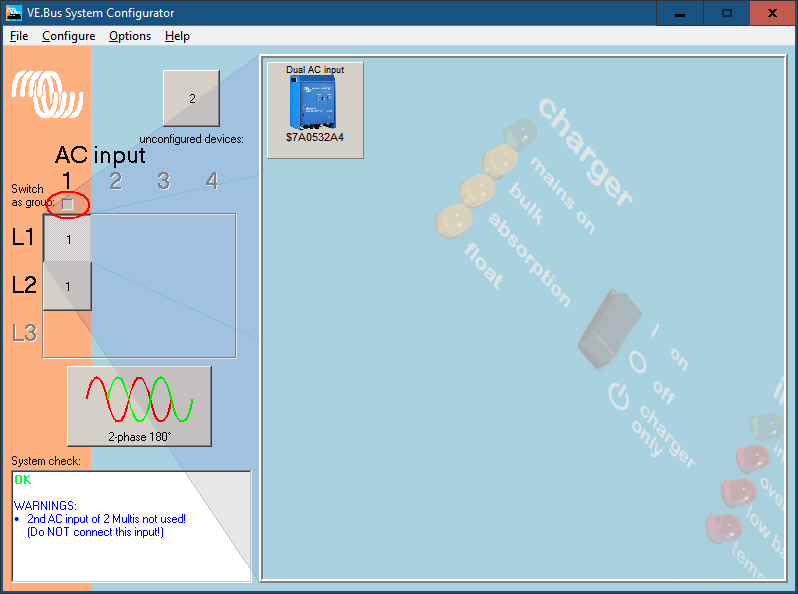I seem to have encountered a major limitation when using two Multiplus units in split phase configuration while supporting both 50A and 30A shore power. It may even be a bug.
I have two 24/3000/70-50 120V (USA) Multiplus units in split phase configuration in an RV. In this configuration I'm able to power both 120V and 240V devices successfully. I have a 50A (split phase) shore power inlet but can also use a 30A (single phase) to 50A adapter if needed. I can begin to charge my batteries with both 50A and 30A shore power -- unless the batteries are too low (huh?? Read on to learn why!).
This setup works great most of the time. There are some problems when using 30A shore power. When on 30A shore power the typical 30A to 50A shore power adapter is wired such that it sends the same 120V phase to both Multiplus units. This results in the second Multiplus detecting that the phase of the power of receives is not the expected 180 degree out of phase. Therefore the second Multiplus rejects the power and only operates in inverting mode, powered from the batteries.
I've encountered two problems/flaws that stem from the above, both of which I believe could theoretically be resolved with software/firmware fixes.
Issue #1:
This one isn't as bad of an issue but it's annoying and is the origin of the major flaw detailed below in issue #2. The issue: I can never run my Multiplus units in 'charge only' mode when on 30A shore power. I get errors if I try. Ideally the second Multiplus would either act as if this was a parallel setup and charge the batteries or simply sleep and let the first Multiplus operate in 'charge only' mode. I am forced to run in inverting+charging mode.
Issue #2 (the bad one):
As noted in Issue #1 above the second Multiplus operates in inverting mode powered by the batteries when on 30A shore power. What happens if your batteries run out and then you plug in to 30A shore power? You can not initiate charging, that's what. This happened to me today when my batteries drained for the first time. I plugged into 30A shore power to charge them and... NOTHING! Errors!
Due to the low voltage in the battery bank the second Multiplus could not enter inverting mode (even though I don't even need it to invert right now). Because of this the first Multiplus refused to operate solo. Despite being plugged into power I was powerless and unable to charge my batteries.
Luckily I was at home and was able to hook up another charger to the bank which provided the voltage to get the second Multiplus up and running. Once I did this the first Multiplus began charging and the temporary charger was no longer needed. I essentially had to do this to 'jump-start' the Multiplus.
Some ideas to work around the issue:
- Carry a spare charger or power source. Costs, takes up space, weight, annoying.
- Auto-transformer. Costs, takes up space, weight, not always needed.
- Raspberry Pi to swap out Multiplus configurations on-demand (e.g. to parallel temporarily for charging while on 30A)... Messy annoying solution.
I don't like any of those options. This is a software problem and I really don't want to spend more money for a worse solution.
Some questions:
- Is there a built-in way to solve this problem without additional hardware (e.g. a configuration setting I'm unaware of)? Is this considered a software BUG?
- Is there any way to get Victron to patch this problem? This isn't too odd of a use case.
- Anyideas of other simple solutions?

